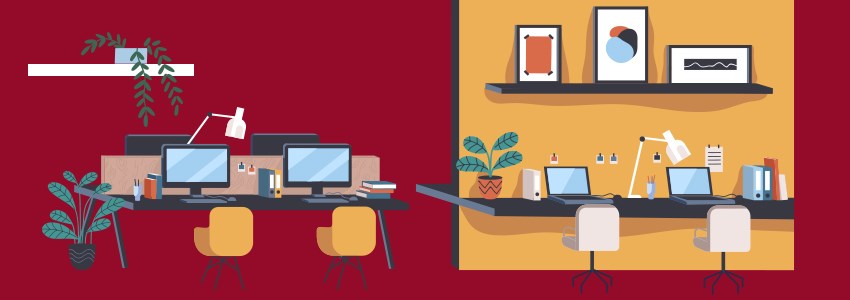Forecasting the future
Workplace trends for 2023

While the pandemic locked us down for a while, it also opened us up to a new way of thinking. The hybrid work model has now become the norm, as businesses around the globe prioritise staff satisfaction, health and wellbeing, and embrace new technologies to create sustainable, more productive ways of working for both people and the planet.
Looking ahead, it's evident that further transformation is in store. Developments and fresh ideas in sustainability, technology, recruitment, and productivity are set to affect our work routines and practices in the coming months and years.
Work produced vs. hours worked
Productivity is top of mind for businesses in these uncertain economic times, which is where staff-centric practices like the hybrid work model and the introduction of a four-day week are coming into play.
The happier the employee, the more productive they are likely to be. As evidenced in a recent New Zealand-based four-day week trial, by consumer goods giant Unilever.
The initiative was one of many similar global trials and involved employees following the 100:80:100 model – which means 100% of pay for 80% of the time, in exchange for a commitment to maintain 100% productivity. Analysis showed strong results against business targets, including revenue growth, with the majority of staff reporting feeling engaged, and absenteeism decreasing by 34%.
Furthermore, individual wellbeing improved, with stress levels dropping by 33% and feelings of strength and vigour increasing by 15%. Work/life conflict fell 67%. Stakeholders and partners also viewed the trial favourably, with 100% agreeing that the team completed work on time and to a high quality.
The four-day week trial was deemed so successful, Unilever is continuing with the experiment here, and extending it to Australia.
55% of Gen Z workers expect the four-day week to become the norm within a few years. (Source: IWG survey)
Meet the Metaverse, our new reality
In case you haven’t already heard of it, the Metaverse is an up-and-coming digital domain that uses cutting-edge internet and semiconductor technologies such as virtual reality, augmented reality, and 3-D capabilities that allow people to have lifelike personal and business experiences online.
It is a trillion-dollar industry that’s expected to see massive uptake within the next five to ten years - with business commentators believing it has the potential to enhance profitability and productivity via increased teleworker camaraderie, improved collaboration, faster, more efficient training, and making work a happier place in general.
In October 2022, Meta CEO Mark Zuckerberg announced that the company would be partnering with Microsoft to bring workplace tools to Virtual Reality (VR), and he unveiled a new VR headset designed specifically with business in mind. Watch this space.
Working from anywhere
As technology advances and our online connections grow, the need to be pinned down in one place for work - indeed in one country - has radically diminished.
It’s estimated that there are currently around 35 million ‘digital nomads’ dotted around the globe, moving from place to place and working remotely. More than 60% of them are under 40 years of age, so the ‘have laptop, will travel’ trend looks set to expand further.
The rise of the side hustle
Not so long ago, it was common for people to complete their education, then get a job with a company that they’d work for until retirement. After that, job hopping became a thing, whereby workers would move between employers to advance their careers.
Today, there’s another shift happening, and it is known as the ‘side hustle’ - i.e. starting up a business alongside a full-time job. It’s a trend that initially gained traction during the pandemic when people had more free time, but it has now become a common way of earning extra income, following a passion - and, for some, engaging in ‘more meaningful’ work.
A 2022 Microsoft survey revealed that nearly 50% of Gen Zers have more than one side hustle. Some employers are hesitant to hire Gen Zers juggling several jobs, but this attitude may hinder recruitment and employee retention, while preventing companies from benefiting from this group of ambitious, productive and highly driven employees.
48% of Gen Z workers have more than one side hustle. (Source: Microsoft)
Placing value on values
Especially during times of challenge and change, businesses that are purpose-driven are more likely to succeed.
Having strong values in place strengthens company culture, steers decision-making, drives performance and brings people together. Research suggests that environmental and social responsibility are of particular importance to today’s employees - with almost half of Gen Zers refusing to join a business that doesn’t have clear environmental and social goals.
Embracing the green lease
Sustainability is high on the agenda for most businesses now, and the hybrid work model is one way they’re effectively reducing emissions. Another way is to consider a ‘green lease’ – whereby both landlords and tenants work together to manage and improve the environmental performance of a building.
This is great for the environment. But it also plays a key role in improving the wellbeing of the building’s occupants, being able to attract and retain top talent through shared core values, and provide tenants with the assurance that their environmental, social, and governance priorities are being met.
More information on green buildings and mitigating climate change from the New Zealand perspective can be found here.
